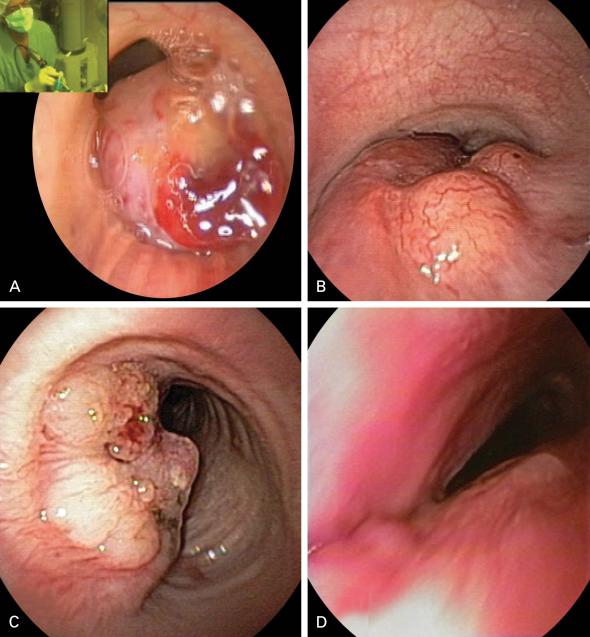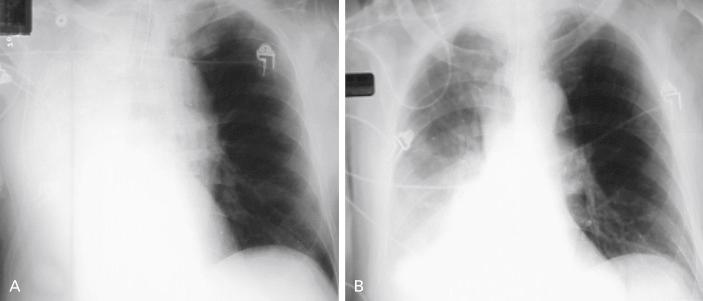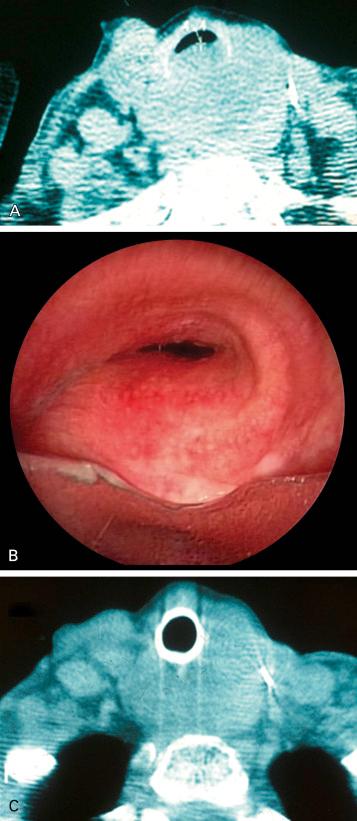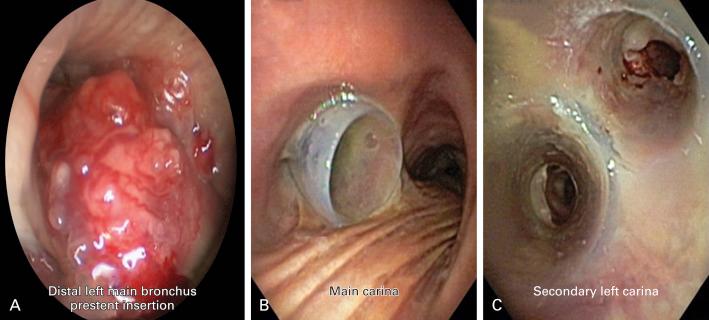Physical Address
304 North Cardinal St.
Dorchester Center, MA 02124
The main oncologic emergencies most germane and specific to lung cancer are central airway obstruction, massive hemoptysis, and massive pleural effusion.
Central airway obstruction due to lung cancer is traditionally classified as exophytic (intraluminal tumor), extrinsic (compression of the airway by tumor within or external to the wall of the airway), or mixed.
Treatment of central airway obstruction generally correlates with the type of lesion: ablative modalities (e.g., laser, cryotherapy, argon plasma coagulation) for exophytic lesions; airway stenting for extrinsic compression; and combined therapies for mixed lesions.
While treatment of central airway obstruction can improve survival, the major aim is the relief of symptoms.
Massive hemoptysis may present in a dramatic fashion and with a rapidly fatal outcome. Rapid, efficient, and expert management and treatment are therefore of paramount importance.
Patients with massive hemoptysis generally die of asphyxiation, not exsanguination, and although not all patients with massive hemoptysis require endotracheal intubation and mechanical ventilation, airway management with vigilant ongoing attention to airway assessment and management is a primary concern.
Endovascular embolization (bronchial artery in 90% of cases) is the mainstay treatment of massive hemoptysis.
Malignant pleural effusion is the most common cause of a massive pleural effusion.
Point-of-care ultrasound is an important part of the evaluation and management of massive pleural effusions.
Indwelling pleural catheters are an effective and safe method to help in the management of symptoms for patients with malignant pleural effusions.
The oncologic emergencies encountered by patients with lung cancer are not exclusive to lung cancer and, for the most part, may affect all cancer patients. Nevertheless, some circumstances and aspects of lung cancer emergencies are unique. Worldwide, lung cancer ranks first in cancer incidence and mortality, but in the United States, it ranks third in incidence behind prostate and breast cancer. Yet, among patients who present to the emergency department, more than three times as many have lung cancer as the next most common type, colorectal cancer. Not surprisingly, respiratory problems are the most common chief complaint for patients with lung cancer on presentation to the emergency department. These patients also appear to be more acutely ill; more than five times as many patients with lung cancer die in the emergency department as compared with patients with colorectal cancer. Although most lung cancer emergencies, such as pneumonia, respiratory failure, neutropenic sepsis, shock, intracranial catastrophe, spinal cord compression, and pathologic fracture, also occur among patients with other cancers, three problems stand out as being most specific and germane to lung cancer, including central airway obstruction, massive hemoptysis, and massive pleural effusions. This chapter offers practical insights and perspectives into the etiology, evaluation, and management of these three complex, controversial, and dreaded complications of lung cancer.
For the purposes of this chapter, central airway obstruction is defined as obstruction of the trachea and main bronchi as well as of the lobar and segmental bronchi. Central airway obstruction is a complex and frequent sign of progressive disease in patients with lung cancer and in patients with malignancies that metastasize to the lungs and airways. Lung cancer-related central airway obstruction often requires emergent evaluation and treatment to prevent hospitalization and admission to the intensive care unit, to control progression of disease, to palliate and treat other life-threatening diseases, and to avoid immediate death.
Central airway obstruction is associated with many presenting signs and symptoms, a handful of diagnostic modalities used in its evaluation, a multitude of available interventional therapies, and, most importantly, a number of patient-related issues relevant to the diagnostic and therapeutic management of this emergency. In this chapter, we briefly address some of these issues as they relate to the oncologist, radiologist, cytopathologist, interventional pulmonologist, critical care specialist, thoracic surgeon, medical ethicist, and radiation oncologist operating as members of a multidisciplinary team for lung cancer management.
Traditionally, central airway obstruction is classified as exophytic (intraluminal), extrinsic (i.e., compression of the airway from tumor beyond or involving the airway wall), or mixed ( Fig. 57.1 ). This classification is enhanced by specifying the location and extent of the airway abnormality; describing whether the obstruction is focal, multifocal, or diffuse; and indicating whether associated abnormalities are present, such as edema, bronchitis, airway necrosis, purulent secretions, obvious infection (which may be primary or secondary), bleeding, perforation or fistula, dehiscence, or airway distortion. It is also helpful to ascertain whether the abnormality is a primary or secondary disorder. For example, central airway obstruction may be a result of new, progressive, or recurrent disease, or it may be an iatrogenic complication after a procedure, such as airway intubation, mechanical ventilation, stent insertion, brachytherapy or laser resection, other bronchoscopic airway manipulation, external-beam radiotherapy, or thoracic surgical intervention.

Additional features that may be relevant in management decisions include whether the obstructing lesion is dynamic (alters the size of the airway during inspiration and expiration) or fixed (airway diameter remains unchanged during respiratory cycles), whether the lesion has associated malacia (softening of airway cartilage) or excessive dynamic airway collapse (exaggerated invagination of the posterior membrane), and the extent to which symptoms adversely affect the patient’s functional status and quality of life. When the airway obstruction has caused an emergency, one must determine whether the emergency is immediately life-threatening. This last point has important implications for diagnosis, treatment, and ethical aspects of care.
The symptoms of central airway obstruction associated with lung cancer are similar to those found in other instances of central airway obstruction and include dyspnea, cough, hemoptysis, hoarseness, and respiratory failure. These symptoms may be progressive or of sudden onset, and can easily be considered to be consistent with the patient’s preexisting symptoms of the lung cancer itself. They can be signs of progressive although manageable disease or represent an immediate precursor or cause of death. Central airway obstruction should be suspected in all cases of new onset or increasing symptoms in any patient with known or suspected lung cancer and in patients who have recently undergone palliative or curative therapeutic interventions for their lung cancer. Of course, a patient’s comorbidities may be contributing to or causing these nonspecific symptoms. The medical evaluation, therefore, must ascertain the presence, severity, and contributing roles of possible heart failure; esophageal extension; pleural disease; other malignancies extending to the lung, mediastinum, and airways; emphysema and chronic bronchitis; pneumonia; radiation-induced lung or airway injury; clinical depression; malnutrition; and failure to thrive.
Central airway obstruction can be suspected during an outpatient clinic visit, prompt the patient to make an emergency room visit, or be responsible for sudden deterioration requiring intubation, hospitalization, or both. Central airway obstruction often requires admission to the intensive care unit. On some occasions, the obstruction is discovered only after a patient has emergency intubation and is placed on mechanical ventilation. In other cases, symptoms of significant obstruction may warrant intubation, raising issues about life-sustaining treatment, appropriate use of medical resources, costs, and roles of palliative care and procedures. A third scenario may involve a patient with dyspnea or other complications who is denied admission to the intensive care unit and further diagnostic evaluation, either because the diagnosis of central airway obstruction is not considered or because the condition is diagnosed but may be considered irreversible. This last scenario raises issues of professionalism, competency, and resource allocation because levels and quality of care depend, in part, on physician expertise, team experience, institutional biases, finances, and societal philosophies regarding extent of care for patients with life-threatening illnesses. Good communication with the patient and with other health-care providers involved in the patient’s care is essential, and a properly executed informed consent is a prerequisite to a thorough understanding of available therapeutic alternatives, including the potential consequences of choosing to accept or refuse minimally invasive surgical interventions.
The setting of emergency central airway obstruction is often complex and stressful for health-care providers, patients, and their families. Patients with malignant central airway obstruction may have a median survival as short as 3 months. One-year survival may be only 15%. In general, the survival rate beyond 90 days in nonsurgical patients with lung cancer requiring admission to the intensive care unit is only 37%, and in the case of associated acute respiratory failure, the prognosis is very poor. Usually, respiratory failure in patients with lung cancer is caused by pneumonia, acute lung injury or acute respiratory distress syndrome, diffuse alveolar hemorrhage, airway bleeding, or venous thromboembolism, as well as central airway obstruction. Mortality increases with the number of failed organs, severity of comorbidities, and presence of airway obstruction. In one study, the hospital mortality rate was 83% for patients with lung cancer and central airway obstruction who were receiving mechanical ventilation, compared with 62% in patients without an obstructed airway. In other studies, when respiratory failure was caused by airway obstruction, only 25% of patients were successfully weaned from mechanical ventilation, although some patients with malignant central airway obstruction benefited from interventional bronchoscopic procedures aimed at restoring airway patency.
The diagnosis of central airway obstruction is made with a combination of clinical findings, radiographic imaging, and bronchoscopic techniques. Because they are noninvasive, chest radiography or computed tomography (CT) is usually performed first. In some life-threatening situations, flexible bronchoscopic inspection is performed to provide immediate information to assist in establishing indications for or against therapeutic interventions to restore airway patency, alleviate dyspnea, postpone or prevent the onset of respiratory failure requiring intubation, or palliate other symptoms (such as hemoptysis).
Findings related to central airway obstruction may include decreased breath sounds on chest auscultation, prolonged expiration, and unilateral wheezing. Patients may lose the ability to phonate in cases where an airway stent has migrated proximally to impinge on the vocal cords from below. Vocal cord paralysis may be suggested by cough, hoarseness, change in voice, or episodes of recurrent aspiration and may be related to a primary lung mass or enlarged mediastinal lymph node impinging on the recurrent laryngeal nerve. Hemoptysis may suggest central airway obstruction in patients with known lung cancer or cancers that are known to metastasize or otherwise spread into the airways (such as colon cancer, malignant melanoma, renal cell carcinoma, thyroid cancer, esophageal cancer, adenoid cystic carcinomas, sarcomas, and some lymphomas).
Chest radiographs may show atelectasis, ipsilateral mediastinal shift, lobar consolidation, stent migration, or a mass impinging on the central airway ( Fig. 57.2 ). CT is used to confirm the diagnosis and obtain more detailed information about the cause, extent, type, and morphology of the obstructing lesion. Associated findings include, among others, mediastinal widening, other lung or airway lesions, pleural disease, volume loss, atelectasis, and consolidation. Patients with a history of radiotherapy may have signs of fibrosis or radiation pneumonitis. CT may also provide information regarding the extent of peribronchial involvement and airway distortion, which may be underestimated by bronchoscopy alone. In some instances, ventilation–perfusion scans can be performed to ascertain whether functional lung exists beyond the level of the obstruction, but the results are not always precise and negative findings do not necessarily preclude successful reestablishment of airway patency and restored ventilation.

Flexible bronchoscopy provides information about the morphology, extent, etiology, and severity of the airway obstruction. It also provides information pertaining to associated airway abnormalities that may affect management decisions and indications for or against palliative or curative interventions to restore airway patency. In experienced hands, airway inspection is performed very quickly with minimal risk to the patient. Depending on the setting, bronchoscopy can be performed through the nares or the mouth (using a bite block), from behind the head of the patient or standing in front of and to the side of the patient, always in conjunction with supplemental oxygen and with or without sedation. For example, in a patient with impending respiratory failure, bronchoscopy can be performed with the patient receiving high-flow oxygen and/or through a continuous positive airway pressure mask, without sedation (to avoid risks of iatrogenic respiratory suppression), and with the patient in the seated position (to avoid aspiration or respiratory suppression related to the supine position). Such a procedure done in the emergency department, hospital ward, or procedure suite may prompt an immediate referral to the operating room for a therapeutic bronchoscopic intervention. If absolutely necessary, the patient can be intubated temporarily with an endotracheal tube over the flexible bronchoscope, or, after appropriate sedation and airway management, intubation can be performed via laryngoscopy before transport to the operating room or interventional bronchoscopy suite.
Patients with a diagnosis of lung cancer–related central airway obstruction require a careful evaluation to obtain information that will guide management. Many decision points must be considered, some of which are disease related, whereas others are lesion related, patient related (e.g., clinical status and treatment preferences), and health-care team related ( Table 57.1 ). To be certain that information is obtained to address each of these aspects of care, a four-step approach can be used that includes an initial evaluation, a review of procedural strategies, procedural techniques and expected/known results, and a long-term management plan ( Table 57.2 ). Many examples for dealing with cancer-related central airway obstruction can be found in the textbook Bronchoscopy and Central Airway Disorders: A Patient-Centered Approach .
| Category | Description |
|---|---|
| Disease related | Severity and extent of comorbid conditions Extent of disease (organ failure, metastases) Prognosis without further systemic therapy Prognosis with additional systemic therapy |
| Lesion related | Extent of abnormalities Duration of central airway obstruction and symptoms of respiratory insufficiency Amenable to bronchoscopic removal or palliation Amenable to stent insertion Potential response to radiotherapy |
| Patient status and preference related | Functional status Expected survival in the absence of central airway obstruction Do-not-resuscitate status Response to informed consent Family support system Risk tolerance Desire to live: goals, expectations |
| Health-care team related | Team experience with bronchoscopic techniques Physician competence and experience Multidisciplinary team management Palliative care and medical ethics consultation availability Resource availability (intensive care unit beds, equipment, instruments) Proactive versus reactive behavioral profiles Realistic, nihilistic, or unrealistic desires and expectations Cost, health-care insurance, societal philosophies regarding resource allocation |
| Initial Evaluation | Procedural Strategies |
|---|---|
|
|
| Procedural Techniques and Results | Long-Term Management Plan |
|---|---|
|
|
The goals of therapy are to restore airway patency, improve symptoms, enhance quality of life, improve patients’ functional status so they may undergo additional systemic or local–regional therapies, transfer hospitalized patients to a lower level of care (from the intensive care unit to the wards or from the wards to home), and increase survival. In recent years, a commonly used therapeutic palliative approach is the combination of endobronchial debulking (using thermal, nonthermal, or mechanical techniques) with or without stent insertion, followed by external-beam radiotherapy and/or systemic therapy, if indicated or possible.
Bronchoscopic laser resection, usually using the neodymium:yttrium aluminum garnet (Nd:YAG) laser, is a mainstay of emergency bronchoscopic intervention for patients with central airway obstruction. Laser can be used in conjunction with mechanical debulking and stent insertion, but requires that the health-care team have experience with laser technologies and, most importantly, knowledge of various laser–tissue interactions related to the use of low- and high-power densities. According to numerous studies, laser resection is an effective palliative procedure for central airway obstruction. Complications are uncommon in well-trained hands, but physicians should always consider the possibility of failure to control the airway, airway fires (especially with indwelling airway stents or endotracheal tubes), failure to control bleeding, and airway necrosis. In general, the depth of penetration of the Nd:YAG laser allows excellent coagulation of vessels that are several millimeters in diameter because this thermal ablative technique achieves substantial vasoconstriction and vaporization of tissues.
Silicone airway stents are extremely valuable for emergency treatment of central airway obstruction. Not only can these stents be deployed, if necessary, without prior thermal ablative techniques, but they also ensure airway patency and give health-care providers time to address other issues relevant to a patient’s care. Data from numerous studies confirm the efficacy of silicone stents to restore and maintain airway patency, although complications such as stent migration, kinking, obstruction by tumor or mucus, and even infection have been reported. Silicone stents, however, require rigid bronchoscopy and general anesthesia. Models are available in all shapes and sizes, including stents that fit onto the carina or secondary bifurcations. By improving functional status, stent insertion allows the medical team to proceed with palliative chemotherapy or radiotherapy if indicated ( Fig. 57.3 ).

Stent insertion becomes necessary when symptomatic airway stenosis is mixed, when stenosis is caused by extrinsic compression, or when a patient has had repeated removal of an intraluminal lesion at short intervals because of a fast-growing tumor. Stent selection has traditionally been based on an operator’s previous experience with a particular stent and the local availability of various stents and other equipment. Stent retrievability is important among patients with malignancy for whom a temporary stent placement is expected; these include patients with malignant central airway obstruction who will undergo further surgical or systemic chemotherapy and/or radiotherapy (e.g., patients with thyroid cancer, primary lung cancer, and esophageal cancer impinging on or involving the airways).
In addition to the morphology and consistency of the tumor, the mechanical properties of the stent should be considered in selecting the appropriate stent. The expansile force (strength) and ability to withhold angulation (also known as buckling) vary among different types of stents. The studded-silicone-type stent has a high expansile force. In a distorted, curved airway, angulation properties are important because they determine whether a stent can conform to the acutely angulated airway and remain patent ( Fig. 57.4 ). Patients with indwelling airway stents benefit from having a stent medical-alert card, which informs emergency room physicians about stent type, size, location, and construction and provides instructions about emergency procedures in case of stent-related complications.

External-beam radiotherapy is a feasible, noninvasive therapeutic alternative, but when the patient has associated severe airway obstruction resulting in atelectasis, the response rate is 20% to 50% in studies involving more than 50 patients. Smaller studies showed that bronchial obstruction can be relieved in up to 74% of patients, resulting in complete or partial reexpansion of the collapsed lung. The time to initiation of treatment matters, because 71% of patients who had radiotherapy within 2 weeks after radiographic evidence of atelectasis had complete reexpansion of their lungs, compared with only 23% among patients having radiotherapy after 2 weeks. The main limitation of external-beam radiotherapy is unwanted exposure of the normal lung parenchyma, heart, spine, and esophagus. Improvements in imaging and treatment planning using three-dimensional conformational radiation and respiratory gating can precisely target radiation delivery and, by decreasing normal tissue margins included to account for uncertainties in position, can diminish the risk of clinically significant pneumonitis and esophagitis. The restoration of airway patency usually improves a patient’s functional status and performance score, accelerates the initiation of systemic therapy if indicated, and can improve survival.
Endobronchial brachytherapy has proven efficacy in patients with endoluminal tumor even when a substantial extrabronchial component is present. This treatment is based on the principle of the inverse square law, which states that dose rate decreases as a function of the inverse square of the distance to the source center, making it possible to achieve a high radiation dose in the center of the radiation source with a fast decrease toward the periphery. Endobronchial brachytherapy offers palliation, with rates of recanalization ranging from 60% to 90%. Symptomatic improvement is seen in 70% to 80% of well-selected patients. The variability in reported results is explained by patient selection, different treatment schemes, and the use of additional treatments. For palliation of symptoms of nonsmall cell lung cancer (NSCLC), however, a Cochrane meta-analysis concluded that endobronchial brachytherapy alone was less effective than external-beam radiotherapy. Endobronchial brachytherapy is usually performed via flexible bronchoscopy. Treatment effects are delayed and complications include hemoptysis, which can be fatal in up to 21% of patients. Other complications include fistula formation, radiation bronchitis (10%), and bronchial stenosis. Squamous cell histology and, most importantly, treatment in the upper lobes are associated with the highest incidence of hemoptysis, probably because of the proximity of the great vessels. Radiation delivered anywhere in the vicinity of major vessels, however, probably increases bleeding risk, as does combined therapy such as laser resection plus endobronchial brachytherapy, which together may augment the likelihood of tissue necrosis. Patients with poor performance status may also be at higher risk for periprocedural complications such as cough, bronchospasm, and pneumothorax caused by placement of the brachytherapy catheter.
Photodynamic therapy can also be performed via flexible bronchoscopy and is approved for local–regional palliation for advanced NSCLC. This modality is most effective when the patient has more than 50% narrowing from mucosal disease. The outcome of photodynamic therapy seems to be the best, however, when patients have a relatively good performance status. In addition, this therapy is less than ideal in the emergency setting because the therapeutic effect is delayed for at least 48 hours and the associated risk of phototoxicity is approximately 20% at 4 weeks after the intervention. Photodynamic therapy may actually worsen airway obstruction during the initial posttreatment period because of sloughing of airway mucosa and retained tumor debris. Sloughed tissue can occlude the airway and cause complete obstruction, resulting in worsening symptoms and postobstructive pneumonia. Similar to endobronchial brachytherapy, photodynamic therapy is contraindicated among patients at high risk for fatal massive hemoptysis. Hemorrhage has been reported for 0% to 2.3% of patients, but the risk may be higher when the disease involves major blood vessels.
Cryotherapy causes thrombosis and necrosis of tumor tissues. Although cryotherapy poses no risk of airway fire or perforation, it can cause cold-induced bronchospasm. Cryotherapy has been shown to be most effective when performed in combination with external-beam radiotherapy. Similar to photodynamic therapy and endobronchial brachytherapy, cryotherapy has a delayed effect and initially may worsen airway obstruction, causing postobstructive pneumonia from sloughed necrotic tissue. Among patients with lung cancer and endoluminal obstruction, cryotherapy is reportedly effective in up to 75% of cases, but it is not a therapy of choice in the emergency setting or when extrinsic compression is present.
Become a Clinical Tree membership for Full access and enjoy Unlimited articles
If you are a member. Log in here